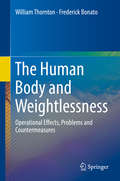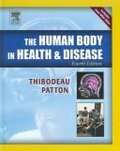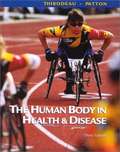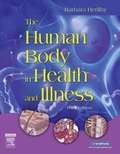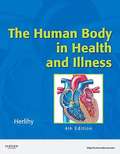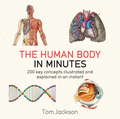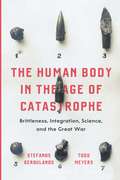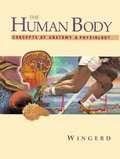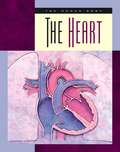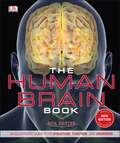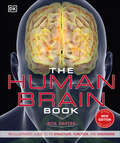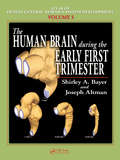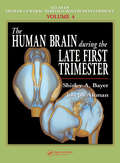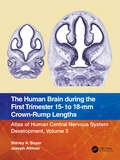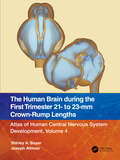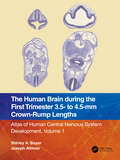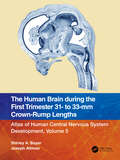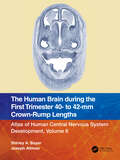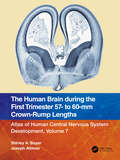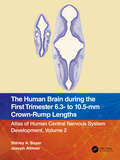- Table View
- List View
The Human Body and Weightlessness
by William Thornton Frederick BonatoThis book focuses on all of the major problems associated with the absence of body weight in space, by analyzing effects, adaption, and re-adaptation upon returning to Earth, using sound scientific principles embedded in a historical context. Serious problems for space travelers range from Space Motion Sickness (SMS) to recently discovered ocular effects that may permanently impair vision. Fluid loss and shifts, spinal changes, and bone and muscle loss are also all results of weightlessness. Starting with a brief definition and history of weightlessness, the authors then address in detail each problem as well as the countermeasures aimed at alleviating them. In some cases, alternative hypotheses regarding what can and should be attempted are also presented. As plans for long-term missions to the Moon and Mars develop, it will be essential to find countermeasures to weightlessness that are effective for missions that could span years.
The Human Body in Health & Disease
by Gary A. Thibodeau Kevin T. PattonOffering a student-friendly writing style, this text presents a body systems approach with a strong emphasis on vocabulary and basic anatomy and physiology concepts, as well as the basic mechanisms of disease and pathologic conditions associated with each body system. This comprehensive text is dominated by two unifying themes: the complementarity of structure and function and homeostasis. The integrating principle of homeostasis is used to show how normal structure and function is achieved and maintained. Failures of homeostasis are shown as basic mechanisms of disease. The reader is drawn into the subject by superior illustrations, including cadaver dissections, and other student-friendly features. Boxed Essays throughout each chapter contain information ranging from clinical applications to sidelights on recent research or topics related to exercise and fitness. Clinical Applications at the end of each chapter offer short case studies with questions that tie theory to practice, and encourage students to apply their knowledge to specific, practical problems. Answers are in the back of the book. Readability and coverage are at the appropriate level for students approaching the study of anatomy and physiology for the first time, with interesting analogies and examples along with the factual information. Superior art program, with over 450 full-color illustrations, complements text material. Chapter Outlines introduce each chapter and preview the content. Objectives contain measurable objectives for students to identify key goals and master information. Detailed Outline Summaries at the end of each chapter provide an excellent recap of important chapter content. New and important vocabulary terms are listed at the end of each chapter, and a comprehensive Glossary provides the full definition for each term. All vocabulary terms in each chapter are provided in bold print. Student self-evaluation activities at the end of each chapter measure their mastery of content. The Chapter Test (answers in back of book), Review Questions and Critical Thinking (answers in Instructors Manual) provide objective and subjective questions and encourage use of critical thinking skills. Pathologic Conditions appendix provides tables summarizing specific pathological conditions by characteristic. Medical Terminology appendix provides a list of word parts commonly used in terms related to medicine and pathology, along with tips on dissecting complex terms to determine their meanings. Clinical Laboratory Values appendix provides commonly observed values for human body content and physiological conditions, along with their normal ranges. New Chemistry of Life chapter discusses basic chemistry concepts needed for understanding basic anatomy and physiology. The Panorama of Anatomy and Physiology/Body Spectrum: Mosbys Electronic Anatomy Coloring Book are included in each textbook. A two-in-one CD-ROM featuring two of popular interactive programs, it simplifies the way students learn anatomy and medical terminology by offering 80 detailed anatomy illustrations that can be colored online or printed out to color and study offline. It also features quizzes, movie clips, fun facts, and information on careers in the field of A&P. New Science Applications boxes are added to each chapter, highlighting the contributions of trailblazing scientists to the field of anatomy and physiology. Study Tips with collaborative learning activities are now listed at the end of each chapter to assist students in how best to study the chapter materials, making this text more student friendly than ever before. New Evolve website provides students access to web links created especially for this text along with online study activities and study tips. It also includes continually updated content, study through the Internet, and
The Human Body in Health & Disease (2nd Edition)
by Gary A. Thibodeau Kevin T. PattonThis updated third edition includes outstanding coverage of basic anatomy and physiology, plus the mechanisms of disease and pathological conditions associated with each body system. Two unifying themes are integrated in this comprehensive text: the complementary nature of structure and function, and homeostasis. Homeostasis is used to show how "normal" structure and function are maintained, whereas failures of homeostasis are shown as basic mechanisms of disease. The reader is drawn into the subject by a clear, straightforward style, superior illustrations, and student-friendly features.
The Human Body in Health & Disease (3rd Edition)
by Gary A. Thibodeau Kevin T. PattonThis third edition includes outstanding coverage of basic anatomy and physiology, plus the mechanisms of disease and pathologic conditions associated with each body system. Two unifying themes are integrated in this comprehensive text: the complementary nature of structure and function, and homeostasis. Homeostasis is used to show how "normal" structure and function are maintained, whereas failures of homeostasis are shown as basic mechanisms of disease. The reader is drawn into the subject by a clear, straightforward style, superior illustrations, and student-friendly features.
The Human Body in Health and Illness (3rd Edition)
by Barbara HerlihyThrough a visually appealing design, The Human Body in Health and Illness, 3rd Edition describes complex concepts in a more simplified way and applies them to patient care. Aimed at students whose background in science is limited, the text assumes the reader has no previous knowledge in biology, chemistry, or physics and makes the information easy to read and understand. The text includes unique cartoons that use humor to make learning the content more enjoyable. The book also employs a body-systems approach to discuss the basic concepts of anatomy and physiology, building up from simple to complex topics. Original, full-color cartoons and illustrations complement the text and reinforce the content, making it accessible and user-friendly. The books logical, step-by-step presentation begins with a basic discussion of the human body and cellular structure and moves toward genetics and the greater complexity of the human organism. Do You Know boxes briefly cover many interesting issues appropriate to anatomy and physiology, including pathophysiology and historical background information. Disorders of the _____ System tables include specific disorders related to individual body systems. As You Age boxes describe how aging affects human anatomy and physiology. Sum It Up! content provides reinforcement and summary of key topics. New chapters on the autonomic nervous system, blood vessel anatomy, and blood vessel circulation take a deeper look into the areas of human anatomy and physiology. The companion Panorama of Anatomy and Physiology/Body Spectrum CD-ROM simplifies the process of learning medical terminology with 80 detailed anatomy illustrations to study, plus quizzes, movie clips, fun facts, and information on careers in the field of A & P.
The Human Body in Health and Illness (4th Edition)
by Barbara HerlihyThe Human Body in Health and Illness, 4th Edition makes it fun to learn anatomy & physiology. Clear, step-by-step explanations provide all the information you need to know, so concepts are easy to understand even if you have a limited background in the sciences. Written by well-known educator Barbara Herlihy, the book begins with a basic discussion of the human body and cellular structure and moves toward genetics and the greater complexity of the human organism. It breaks down complex concepts and processes into digestible chunks, and new features such as Re-Think and Go Figure! help you apply what you've learned to common problems in patient care. Unique! Original, colorful cartoons use humor to reinforce content, making it more accessible and user-friendly. Original, full-color illustrations complement the text and simplify both fundamental and complex concepts. Key terms are listed in chapter openers and defined in the glossary. A summary outline at the end of each chapter provides a useful study tool. Review Your Knowledge questions at the end of each chapter include multiple-choice and matching Unique! Do You Know boxes discuss pathophysiology issues or provide a historical connection to A&P. Unique! Disorders of the System tables summarize specific disorders related to individual body systems for easy reference. Sum It Up! reinforces and summarizes key topics. As You Age boxes describe how aging affects human anatomy and physiology. An updated Evolve companion website provides access to post-tests, animations, an audio glossary, and additional Do You Know vignettes. Re-Think sections ask you to review concepts and apply what you've learned. Unique! Ramp It Up! boxes connect material in the text to the clinical setting and your future career. Unique! Build-a-Word boxes help you learn and build upon new medical terminology. Unique! Go Figure! features ask you to reexamine diagrams, reinforcing the key points of each one. Unique! Bridges to Nursing Assessment Labs on the companion Evolve website bridge the gap between A&P theory and clinical application.
The Human Body in Minutes (IN MINUTES)
by Tom JacksonA concise and illuminating tour of the human body - learn about how our bodies work and why they work the way they do, in minutes. From the basic unit of the cell, through the tissues and organs that make up the body's systems, to how these systems work together to form a complete human being, this book takes you on a journey through our anatomy and its intricate workings - and looks beyond to explore human evolution, inheritence and genetics, human behaviour, disease, death and medicine and how technology will transform the body of the future.With 200 cutting-edge anatomical images, cross-sections and close-ups that detail and explain the brain, eye, heart, skin, skeleton, lung, kidney, ear, blood, liver, stomach, muscles, veins, arteries, DNA, chromosomes and all of the key features of our bodies, this is the perfect, easy reference to the anatomy, physiology and science of the human body.
The Human Body in the Age of Catastrophe: Brittleness, Integration, Science, and the Great War
by Stefanos Geroulanos Todd MeyersThe injuries suffered by soldiers during WWI were as varied as they were brutal. How could the human body suffer and often absorb such disparate traumas? Why might the same wound lead one soldier to die but allow another to recover? In The Human Body in the Age of Catastrophe, Stefanos Geroulanos and Todd Meyers uncover a fascinating story of how medical scientists came to conceptualize the body as an integrated yet brittle whole. Responding to the harrowing experience of the Great War, the medical community sought conceptual frameworks to understand bodily shock, brain injury, and the vast differences in patient responses they occasioned. Geroulanos and Meyers carefully trace how this emerging constellation of ideas became essential for thinking about integration, individuality, fragility, and collapse far beyond medicine: in fields as diverse as anthropology, political economy, psychoanalysis, and cybernetics. Moving effortlessly between the history of medicine and intellectual history, The Human Body in the Age of Catastrophe is an intriguing look into the conceptual underpinnings of the world the Great War ushered in.
The Human Body: Concepts Of Anatomy And Physiology
by Bruce D. WingerdThis text is developed specifically for the one-term market and offers the essentials of anatomy and physiology in a direct, concise format. Students benefit from striking and precise full-color art that enhances the author's straightforward, clear writing style. The author's vast teaching experience enables him to accurately present the appropriate vocabulary and detail that an allied health/physical education major needs.
The Human Body: The Heart
by Susan H. GrayThis book talks about all the interesting details about one of the most important organs in the human body -- heart.
The Human Brain Book
by Rita CarterThis award-winning science book uses the latest findings from neuroscience research and brain-imaging technology to take you on a journey into the human brain. The book answers fundamental and compelling questions about the brain: what does it mean to be conscious, what happens when we're asleep, and are the brains of men and women different? The Human Brain Book provides an up-to-date guide to one of science's most exciting frontiers. With its coverage of more than 50 brain-related diseases and disorders--from strokes to brain tumors and schizophrenia--it is also an essential manual for students and healthcare professionals.
The Human Brain Book: An Illustrated Guide to its Structure, Function, and Disorders (DK Human Body Guides)
by Rita CarterThe Human Brain Book is a complete guide to the one organ in the body that makes each of us what we are - unique individuals. It combines the latest findings from the field of neuroscience with expert text and state-of-the-art illustrations and imaging techniques to provide an incomparable insight into every facet of the brain. Layer by layer, it reveals the fascinating details of this remarkable structure, covering all the key anatomy and delving into the inner workings of the mind, unlocking its many mysteries, and helping you to understand what's going on in those millions of little gray and white cells. Tricky concepts are illustrated and explained with clarity and precision, as The Human Brain Book looks at how the brain sends messages to the rest of the body, how we think and feel, how we perform unconscious actions (for example breathing), explores the nature of genius, asks why we behave the way we do, explains how we see and hear things, and how and why we dream. Physical and psychological disorders affecting the brain and nervous system are clearly illustrated and summarized in easy-to-understand terms. The unique DVD brings the subject to life with interactive elements. These include a clickable model of the brain's structure that allows the user to zoom in and discover deeper layers of detail, while complex processes, such as the journey of a nerve impulse, are broken down and simplified through intuitive animations.
The Human Brain During the Early First Trimester (Atlas of Human Central Nervous System Development)
by Shirley A. Bayer Joseph AltmanThis is the fifth and last Volume in the Atlas of Human Central Nervous System Development Series. It deals with human brain development during the early first trimester from the third through the seventh gestational weeks. Serial sections from 14 specimens are illustrated and annotated in detail, together with 3?D reconstructions of the brains of
The Human Brain During the Late First Trimester
by Shirley A. Bayer Joseph AltmanThe fourth volume in the Atlas of Human Central Nervous System Development series, The Human Brain During the Late First Trimester provides new information about features of the perinatal brain. It deals with brain development during the late first trimester (GW11-GW7.5). The major theme of this volume is the identification of stretches and patches
The Human Brain during the First Trimester 15- to 18-mm Crown-Rump Lengths: Atlas of Human Central Nervous System Development, Volume 3
by Shirley A. Bayer Joseph AltmanThis third of 15 short atlases reimagines the classic 5-volume Atlas of Human Central Nervous System Development. This volume presents serial sections from specimens between 15 mm and 18 mm with detailed annotations, together with 3D reconstructions. An introduction summarizes human CNS development by using high-resolution photos of methacrylate-embedded rat embryos at a similar stage of development as the human specimens in this volume. The accompanying Glossary gives definitions for all the terms used in this volume and all the others in the Atlas. Features Classic anatomical atlas Detailed labeling of structures in the developing brain offers updated terminology and the identification of unique developmental features, such as germinal matrices of specific neuronal populations and migratory streams of young neurons Appeals to neuroanatomists, developmental biologists, and clinical practitioners A valuable reference work on brain development that will be relevant for decades
The Human Brain during the First Trimester 21- to 23-mm Crown-Rump Lengths: Atlas of Human Central Nervous System Development, Volume 4
by Shirley A. Bayer Joseph AltmanThis fourth of 15 short atlases reimagines the classic 5-volume Atlas of Human Central Nervous System Development. This volume presents serial sections from specimens between 21 mm and 23 mm with detailed annotations, together with 3D reconstructions. An introduction summarizes human CNS development by using high-resolution photos of methacrylate-embedded rat embryos at a similar stage of development as the human specimens in this volume. The accompanying Glossary gives definitions for all the terms used in this volume and all the others in the Atlas. Key Features Classic anatomical atlases Detailed labeling of structures in the developing brain offers updated terminology and the identification of unique developmental features, such as, germinal matrices of specific neuronal populations and migratory streams of young neurons Appeals to neuroanatomists, developmental biologists, and clinical practitioners. A valuable reference work on brain development that will be relevant for decades
The Human Brain during the First Trimester 3.5- to 4.5-mm Crown-Rump Lengths: Atlas of Human Central Nervous System Development, Volume 1
by Shirley A. Bayer Joseph AltmanThis first of 15 short atlases reimagines the classic 5-volume Atlas of Human Central Nervous System Development. This volume presents serial sections from specimens between 3.5 mm and 4.5 mm with detailed annotations, together with 3D reconstructions. An introduction summarizes human CNS development by using high-resolution photos of methacrylate-embedded rat embryos at a similar stage of development as the human specimens in this volume. The accompanying Glossary gives definitions for all the terms used in this volume and all the others in the Atlas. Features Classic anatomical atlas Detailed labeling of structures in the developing brain offers updated terminology and the identification of unique developmental features, such as germinal matrices of specific neuronal populations and migratory streams of young neurons Appeals to neuroanatomists, developmental biologists, and clinical practitioners A valuable reference work on brain development that will be relevant for decades
The Human Brain during the First Trimester 31- to 33-mm Crown-Rump Lengths: Atlas of Human Central Nervous System Development, Volume 5
by Shirley A. Bayer Joseph AltmanThis fifth of 15 short atlases reimagines the classic 5-volume Atlas of Human Central Nervous System Development. This volume presents serial sections from specimens between 31 mm and 33 mm with detailed annotations, together with 3D reconstructions. An introduction summarizes human CNS development by using high-resolution photos of methacrylate-embedded rat embryos at a similar stage of development as the human specimens in this volume. The accompanying Glossary gives definitions for all the terms used in this volume and all the others in the Atlas. Features Classic anatomical atlases Detailed labeling of structures in the developing brain offers updated terminology and the identification of unique developmental features, such as, germinal matrices of specific neuronal populations and migratory streams of young neurons Appeals to neuroanatomists, developmental biologists, and clinical practioners A valuable reference work on brain development that will be relevant for decades
The Human Brain during the First Trimester 40- to 42-mm Crown-Rump Lengths: Atlas of Human Central Nervous System Development, Volume 6
by Shirley A. Bayer Joseph AltmanThis sixth of 15 short atlases reimagines the classic 5-volume Atlas of Human Central Nervous System Development. This volume presents serial sections from specimens between 40 mm and 42 mm with detailed annotations, together with 3D reconstructions. An introduction summarizes human CNS development by using high-resolution photos of methacrylate-embedded rat embryos at a similar stage of development as the human specimens in this volume. The accompanying Glossary gives definitions for all the terms used in this volume and all the others in the Atlas. Features Classic anatomical atlas Detailed labeling of structures in the developing brain offers updated terminology and the identification of unique developmental features, such as, germinal matrices of specific neuronal populations and migratory streams of young neurons Appeals to neuroanatomists, developmental biologists, and clinical practitioners A valuable reference work on brain development that will be relevant for decades
The Human Brain during the First Trimester 57- to 60-mm Crown-Rump Lengths: Atlas of Human Central Nervous System Development, Volume 7
by Shirley A. Bayer Joseph AltmanThe seventh of 15 short atlases reimagining the classic 5-volume Atlas of Human Central Nervous System Development. This volume presents serial sections from specimens between 57 mm and 60 mm with detailed annotations, together with 3D reconstructions. An introduction summarizes human CNS development by using high-resolution photos of methacrylate-embedded rat embryos at a similar stage of development as the human specimens in this volume. The accompanying Glossary gives definitions for all the terms used in this volume and all the others in the Atlas. Features • Classic anatomical atlas • Detailed labeling of structures in the developing brain offers updated terminology and the identification of unique developmental features, such as, germinal matrices of specific neuronal populations and migratory streams of young neurons • Appeals to neuroanatomists, developmental biologists, and clinical practitioners • A valuable reference work on brain development that will be relevant for decades
The Human Brain during the First Trimester 6.3- to 10.5-mm Crown-Rump Lengths: Atlas of Human Central Nervous System Development, Volume 2
by Shirley A. Bayer Joseph AltmanThis second of 15 short atlases reimagines the classic 5-volume Atlas of Human Central Nervous System Development. This volume presents serial sections from specimens between 6.3 mm and 10.5 mm with detailed annotations, together with 3D reconstructions. An introduction summarizes human CNS development by using high-resolution photos of methacrylate-embedded rat embryos at a similar stage of development as the human specimens in this volume. The accompanying Glossary gives definitions for all the terms used in this volume and all the others in the Atlas. Features Classic anatomical atlas Detailed labeling of structures in the developing brain offers updated terminology and the identification of unique developmental features, such as, germinal matrices of specific neuronal populations and migratory streams of young neurons Appeals to neuroanatomists, developmental biologists, and clinical practitioners A valuable reference work on brain development that will be relevant for decades
The Human Brain during the Second Trimester 160– to 170–mm Crown-Rump Lengths: Atlas of Human Central Nervous System Development, Volume 9
by Shirley A. Bayer Joseph AltmanThis ninth of 15 short atlases reimagines the classic 5-volume Atlas of Human Central Nervous System Development. This volume presents serial sections from specimens between 160 mm and 170 mm with detailed annotations. An introduction summarizes human CNS developmental highlights around 5 months of gestation. The Glossary (available separately) gives definitions for all the terms used in this voume and all the others in the Atlas. Features • Classic anatomical atlas • Detailed labeling of structures in the developing brain offers updated terminology and the identification of unique developmental features, such as germinal matrices of specific neuronal populations and migratory streams of young neurons • Appeals to neuroanatomists, developmental biologists, and clinical practitioners • A valuable reference work on brain development that will be relevant for decades
The Human Brain during the Second Trimester 190– to 210–mm Crown-Rump Lengths: Atlas of Human Central Nervous System Development, Volume 10
by Shirley A. Bayer Joseph AltmanThis tenth of 15 short atlases reimagines the classic 5-volume Atlas of Human Central Nervous System Development. This volume presents serial sections from specimens between 190 mm and 210 mm with detailed annotations. An introduction summarizes human CNS developmental highlights around 5 months of gestation. The Glossary (available separately) gives definitions for all the terms used in this volume and all the others in the Atlas. Features • Classic anatomical atlas • Detailed labeling of structures in the developing brain offers updated terminology and the identification of unique developmental features, such as germinal matrices of specific neuronal populations and migratory streams of young neurons • Appeals to neuroanatomists, developmental biologists, and clinical practitioners • A valuable reference work on brain development that will be relevant for decades
The Human Brain during the Second Trimester 96– to 150–mm Crown-Rump Lengths: Atlas of Human Central Nervous System Development, Volume 8
by Shirley A. Bayer Joseph AltmanThis eighth of 15 short atlases reimagines the classic 5-volume Atlas of Human Central Nervous System Development. This volume presents serial sections from specimens between 96 mm and 150 mm with detailed annotations. An introduction summarizes human CNS developmental highlights between 3.5 and 4.5 months of gestation. The accompanying Glossary (available free online) gives definitions for all the labels used in this volume and all the others in the Atlas. Key Features • Classic anatomical atlas • Detailed labeling of structures in the developing brain offers updated terminology and the identification of unique developmental features such as germinal matrices of specific neuronal populations and migratory streams of young neurons • Appeals to neuroanatomists, developmental biologists, and clinical practitioners • A valuable reference work on brain development that will be relevant for decades
The Human Brain during the Third Trimester 225– to 235–mm Crown-Rump Lengths: Atlas of Central Nervous System Development, Volume 11
by Shirley A. Bayer Joseph AltmanThis eleventh of 15 short atlases reimagines the classic 5-volume Atlas of Human Central Nervous System Development. This volume presents serial sections from specimens between 225 mm and 235 mm with detailed annotations. An introduction summarizes human CNS developmental highlights around 6.5 months of gestation. The Glossary (available separately) gives definitions for all the terms used in this volume and all the others in the Atlas. Key Features • Classic anatomical atlases • Detailed labeling of structures in the developing brain offers updated terminology and the identification of unique developmental features, such as germinal matrices of specific neuronal populations and migratory streams of young neurons • Appeals to neuroanatomists, developmental biologists, and clinical practitioners • A valuable reference work on brain development that will be relevant for decades
